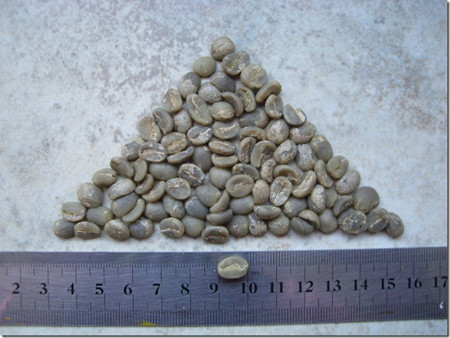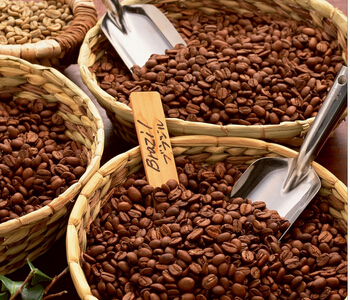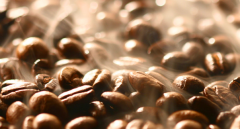How to wash coffee beans? how to wash coffee beans? What do I do with raw coffee beans? How to clear
Coffee raw beans are the state of coffee beans before they are roasted, and the processing process of coffee raw beans is more troublesome. Today we will talk about how to wash coffee raw beans, that is, the step of washing coffee raw beans.

The so-called washing method means that the coffee fruit is immediately picked when it turns red, the hard peel is removed by machine, the sticky berries are exposed, and then thrown into the pool to ferment. In about a day or two, the bacteria will eat most of the pulp attached to the seeds. The whole fermentation process needs to be monitored by the old master, if it goes too far, it will destroy the quality of coffee beans. After the berries are removed by fermentation, rinse the residual pulp attached to the seeds with clean water.
At this time, the seed has been taken out, and then the drying process, it is best to lay the ground for the sun to dry, the flavor is better, but if it rains, it can also be dried by machine, but the temperature should be controlled. Dry and then polish. Generally speaking, washed beans are bluish green, beautiful, and have a clear and bright sour taste. Guatemala, Colombia, Blue Mountains, Cana, Kenya, Java and Panama coffee are all washed beans. Washing is used in Latin America with the exception of Brazil.
The rule of the sun is to take the red fruit to dry directly and then force peeling and shelling. In this way, beans are often defective and not very beautiful. The appearance of the common foreign body or stone bean appearance of the sun-dried beans is more incomplete, the flavor of the beans treated by this method is more complex, with the taste of the sun, the fruit flavor is very strong, and the consistency is better than the washing method, but the bean phase is not good. General Brazilian beans as well as Manning and mocha are typical sun-treated beans.
Let's talk about the natural sun method: this method is the oldest way to get seeds, and it is easier than washing. Wash the fruit and pick it when it turns red, ignore the sun rule, continue to make the fruit purple and black, and finally fall off on its own, then spread the fruit in the sun for a few weeks, and then remove the seeds naturally after the pulp is dry, and then remove the stiff pulp by machine or manual grinding. The focus of late harvest is to let the seeds fully absorb the aroma and sweetness of the pulp, and then after exposure, the flavor is more complex than water-washed beans, and the consistency is also good. Yemenmoka, Harald, Ethiopia, and some Brazilian manor beans all fall into this category.
Finally, the semi-washing method. The first step is the same as washing. The fruit is picked when it turns red, but it is not thrown into the fermentation tank. Instead, the peel is removed by a machine, the berries are spread on the ground, dried and moistened, and the dried flesh is ground with a special machine to remove the seeds. Most of Mantenin in Indonesia adopts semi-washing method. Brazil has also begun to use semi-washing in recent years, which is the only one in the world that has both sun exposure. The country of production of these three treatments: water washing and semi-washing.
Important Notice :
前街咖啡 FrontStreet Coffee has moved to new addredd:
FrontStreet Coffee Address: 315,Donghua East Road,GuangZhou
Tel:020 38364473
- Prev

Is there any recommended coffee bean Taobao store? Coffee beans in Taobao Shop
There are few kinds of beans, and the classification is traditional, but the source of raw beans is good, the quality is stable, the technology is good, and the price ~ ~ different opinions ~ ~ if it is a boutique cafe operation, I recommend using the coffee shop in Guangzhou ~ to pursue the Japanese style. I recommend that Shanghai Lao Yuan is Ka Lu Meng. His family started early, has a wide range of beans, and has many kinds.
- Next

How do you classify coffee beans? What kind of coffee beans are good? What kind of coffee beans are of good quality?
Small round beans in coffee beans: there are usually two seeds in a coffee fruit, but after picking, there is usually only one seed in about 5-10% of the berries, because only one ovule was fertilized in the ovary. When this bean grows, it will be close to an oval shape, which is commonly known as the small round bean. This coffee bean will be smaller than normal Arabica coffee beans.
Related
- Guji coffee producing area of Guji, Ethiopia: Humbela, Shakiso, Wulaga
- What is the most expensive variety of Qiloso in BOP multi-variety group?
- How to store the coffee beans bought home?
- Why are Yemeni coffee beans so rare now?
- Ethiopian Sidamo all Red Fruit Sun Sun Santa Vini Coffee beans
- SOE is mostly sour? What does it mean? Is it a single bean? what's the difference between it and Italian blending?
- Is Italian coffee beans suitable for making hand-brewed coffee?
- How to choose coffee beans when making cold coffee? What kind of coffee beans are suitable for making cold coffee?
- Just entered the pit to make coffee, what kind of coffee beans should be chosen?
- Can only Japan buy real Blue Mountain Coffee? What are authentic Jamaican Blue Mountain coffee beans?

